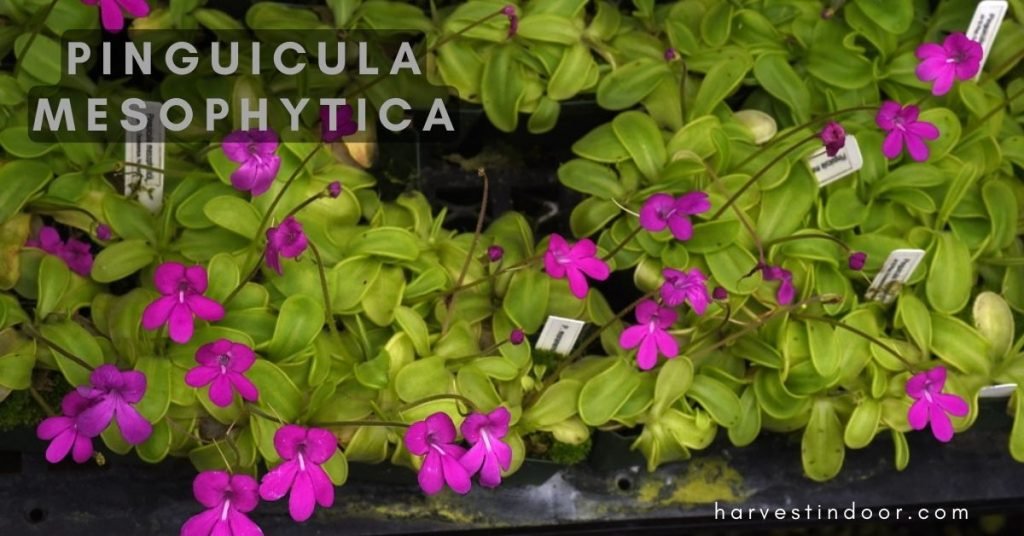Welcome to the captivating realm of Pinguicula Mesophytica, a remarkable carnivorous plant that possesses a host of intriguing qualities. With its ability to lure, capture, and digest insects, this plant has fascinated botany enthusiasts and nature lovers alike.

In this comprehensive guide, we will delve into the depths of Pinguicula Mesophytica, exploring its habitat, cultivation techniques, adaptations, and ecological significance. Join us on this captivating journey as we uncover the secrets of this unique species.
Table of Contents
Pinguicula Mesophytica: An Overview
Pinguicula Mesophytica, commonly known as the Butterwort, is a carnivorous plant belonging to the Lentibulariaceae family. This remarkable plant is native to [insert native regions], where it thrives in diverse ecosystems, including bogs, swamps, and wet meadows. The name “Pinguicula” derives from the Latin word “pinguis,” which means “fat” or “greasy,” referring to the plant’s glistening leaves.
Habitat and Distribution
Pinguicula Butterwort can be found in various regions across the globe. Its natural habitat spans from [insert regions and countries] to [insert regions and countries]. This adaptable species thrives in damp environments characterized by high humidity levels, making it well-suited to boggy areas and wetlands.
Cultivation and Care
Growing Butterwort Mesophytica can be a rewarding experience for plant enthusiasts. Here are some key points to consider when cultivating and caring for these captivating carnivorous plants:
- Soil Requirements: Butterwort thrives in a well-draining, nutrient-poor soil mix. A recommended mix includes sphagnum moss, perlite, and sand.
- Light Conditions: These plants prefer bright, indirect light. A location with filtered sunlight or partial shade is ideal.
- Watering: Pinguicula requires constant moisture. Water the plant with distilled or rainwater to avoid mineral buildup.
- Feeding: As carnivorous plants, Pinguicula Mesophytica obtains nutrients from insects. Avoid fertilizing these plants, as they rely on capturing and digesting prey.
- Dormancy: Some Butterwort species undergo a period of dormancy during winter. It is essential to provide the plant with a cool and relatively dry environment during this time.
Adaptable and Fascinating: The Adaptations of Butterwort
Pinguicula Mesophytica boasts several remarkable adaptations that enable it to thrive in its unique habitat. These adaptations not only facilitate its carnivorous nature but also enhance its survival capabilities. Let’s explore some of the key adaptations of Pinguicula Mesophytica:
- Sticky Glandular Leaves: The leaves of Pinguicula Butterwort are covered with glandular hairs that secrete a sticky substance. This sticky coating enables the plant to trap insects, which subsequently become a source of nutrients.
- Modified Leaf Structure: Pinguicula Mesophytica possesses specialized leaves that are broad and flat, forming a rosette-like arrangement. This leaf structure maximizes the plant’s surface area for insect capture.
- Digestive Enzymes: Once an insect is trapped on the leaves, Pinguicula Mesophytica releases digestive enzymes that break down the prey. The plant then absorbs the nutrients, supplementing its nutrient-poor habitat.
- Coloration and Camouflage: The leaves of Pinguicula Mesophytica exhibit various colors, including shades of green, red, and purple. These pigments aid in attracting insects, enticing them to land on the plant’s sticky surface.
- Reduced Root System: Pinguicula Mesophytica has a relatively small root system. This adaptation is a result of the plant’s ability to obtain nutrients from captured insects, reducing its reliance on traditional root-based nutrient absorption.
The Ecological Importance of Pinguicula Mesophytica

Beyond its captivating nature, Pinguicula Mesophytica plays a vital ecological role. As a carnivorous plant, it contributes to the delicate balance of its ecosystem. Some key ecological aspects include:
- Insect Control: Butterwort helps regulate insect populations in its habitat. By capturing and consuming insects, it contributes to the natural control of insect populations in wetland areas.
- Biodiversity Support: The presence of Pinguicula Mesophytica in wetland ecosystems supports biodiversity by providing a unique habitat for various insect species. This, in turn, attracts other organisms further up the food chain.
- Indicator Species: Pinguicula Mesophytica serves as an indicator species for the health of wetland environments. Its presence or absence can provide valuable insights into the overall well-being of these delicate ecosystems.
Frequently Asked Questions (FAQs)
Q: What is the origin of the name “Pinguicula Mesophytica”?
The name “Pinguicula Mesophytica” derives from the Latin word “pinguis,” meaning “fat” or “greasy.” It refers to the plant’s glistening leaves that appear as if coated in grease.
Q: Can Butterwort be grown indoors?
Yes, Butterwort can be successfully grown indoors. Ensure that the plant receives adequate light, moisture, and a suitable growing medium to replicate its natural habitat.
Q: How often should I feed Pinguicula Mesophytica?
Butterwort obtains nutrients through the capture and digestion of insects. Feeding intervals will depend on the availability of prey in your area and the size of the plant.
Q: Is Pinguicula Mesophytica easy to care for?
With proper understanding and care, Pinguicula Butterwort Mesophytica can be relatively easy to care for. Maintaining the right moisture levels, light conditions, and appropriate soil mix will contribute to its overall health and vitality.
Q: Are all Pinguicula Mesophytica species insectivorous?
Yes, all species within the Pinguicula Mesophytica genus are carnivorous and rely on the capture and digestion of insects for their nutritional needs.
Q: How can I propagate Pinguicula Mesophytica?
Pinguicula Butterwort can be propagated through various methods, including leaf cuttings and division. Research the specific propagation techniques for the particular species you are working with to ensure successful results.
Conclusion
In conclusion, Pinguicula Butterwort stands as a testament to nature’s incredible adaptations and diversity. This captivating carnivorous plant enthralls us with its sticky leaves, intricate adaptations, and crucial ecological contributions.
Whether you are a botany enthusiast, a nature lover, or a curious learner, exploring the realm of Pinguicula Mesophytica is a journey well worth embarking on. So, immerse yourself in the world of this remarkable plant and witness its beauty and functionality in the intricate web of life.

Gardening is my passion and growing plants indoors has always been a stress relief for me. Grow a banana tree in my apartment once (although failed to produce bananas).






